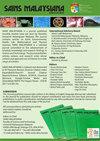Human Mesenchymal Stem Cell Derived from Bone Marrow and Umbilical Cord Display Anti-Cancer Activity in Cancer Cell Lines in Vitro
IF 0.8
4区 综合性期刊
Q3 MULTIDISCIPLINARY SCIENCES
引用次数: 0
Abstract
The anti-tumour efficacy of engineered mesenchymal stem cell (MSCs) in cancers have been well documented by several reports. However, the impact of MSCs on the pathogenesis of solid cancers remains elusive. The study aims to elucidate the role of MSCs from bone marrow (BMMSCs) and umbilical cord (UCMSCs) on the proliferation, apoptosis and clonogenicity of cancer cell including H2170 (squamous cell carcinoma), LN18 (glioblastoma) and MCF7 (breast cancer) in vitro. Highest concentration of conditioned medium derived from the UCMSCs was significantly (p<0.001) effective to inhibit the proliferation of H2170 (25.8 ± 3.5%), LN18 (17.6 ± 6.5%) and MCF7 (33.2 ± 6.8%) as compared to 100% viability in basal. Both MSCs and its conditioned medium were able to significantly (p<0.001) induce apoptosis (early and late) to the H2170 and LN18 cells. However, for MCF7 cells, co-cultured with both MSCs had higher impact on the apoptosis as compared to their condition medium. Furthermore, conditioned medium from UCMSCs were able to significantly reduced the number of colonies in H2170 (609.5 ± 4.9) and LN18 (171.3 ± 12.6) as compared to control (H2170; 1196.3 ±12.8 and LN18; 253.3 ± 12.3), suggesting that these two cancer cells are sensitive to the MSCs. Notably, by co-culturing of all three cancer cell lines with the MSCs’ conditioned medium, we found that there was an increased expression of more than two-fold in BAX, BAD, and APAF1 genes showing the ability of MSCs’ conditioned medium to induce the intrinsic apoptosis pathway in the cancer cells. Collectively, our findings demonstrated that the MSCs could induce apoptosis and inhibit both H2170 and LN18 cancer cell proliferation. Furthermore, this study did not find evidence of MSCs in enhancing tumorigenic characteristics of these cancer cells, and thus we postulate that MSCs are basically safe as a cell-based therapy in cancer treatment.从骨髓和脐带中提取的人类间充质干细胞在体外癌症细胞系中显示出抗癌活性
工程间充质干细胞(MSCs)在癌症中的抗肿瘤疗效已被多篇报道所证实。然而,间充质干细胞对实体瘤发病机理的影响仍然难以捉摸。本研究旨在阐明骨髓间充质干细胞(BMMSCs)和脐带间充质干细胞(UCMSCs)在体外对包括H2170(鳞癌)、LN18(胶质母细胞瘤)和MCF7(乳腺癌)在内的癌细胞的增殖、凋亡和克隆性的作用。由 UCMSCs 提取的最高浓度的条件培养基对 H2170(25.8 ± 3.5%)、LN18(17.6 ± 6.5%)和 MCF7(33.2 ± 6.8%)的增殖抑制效果显著(p<0.001),而基础培养基的存活率为 100%。间充质干细胞及其条件培养基都能显著(p<0.001)诱导 H2170 和 LN18 细胞凋亡(早期和晚期)。然而,对于 MCF7 细胞来说,与两种间充质干细胞共培养对细胞凋亡的影响要高于其条件培养基。此外,与对照组(H2170;1196.3 ±12.8 和 LN18;253.3 ± 12.3)相比,来自 UCMSCs 的条件培养基能显著减少 H2170(609.5 ± 4.9)和 LN18(171.3 ± 12.6)的菌落数,这表明这两种癌细胞对间叶干细胞很敏感。值得注意的是,通过将三种癌细胞株与间充质干细胞条件培养液共培养,我们发现 BAX、BAD 和 APAF1 基因的表达量增加了两倍多,这表明间充质干细胞条件培养液能够诱导癌细胞的内在凋亡通路。总之,我们的研究结果表明,间充质干细胞能诱导 H2170 和 LN18 癌细胞凋亡并抑制其增殖。此外,本研究没有发现间充质干细胞增强这些癌细胞致瘤特性的证据,因此我们推测间充质干细胞作为一种基于细胞的癌症治疗方法是基本安全的。
本文章由计算机程序翻译,如有差异,请以英文原文为准。
求助全文
约1分钟内获得全文
求助全文
来源期刊

Sains Malaysiana
MULTIDISCIPLINARY SCIENCES-
CiteScore
1.60
自引率
12.50%
发文量
196
审稿时长
3-6 weeks
期刊介绍:
Sains Malaysiana is a refereed journal committed to the advancement of scholarly knowledge and research findings of the several branches of science and technology. It contains articles on Earth Sciences, Health Sciences, Life Sciences, Mathematical Sciences and Physical Sciences. The journal publishes articles, reviews, and research notes whose content and approach are of interest to a wide range of scholars. Sains Malaysiana is published by the UKM Press an its autonomous Editorial Board are drawn from the Faculty of Science and Technology, Universiti Kebangsaan Malaysia. In addition, distinguished scholars from local and foreign universities are appointed to serve as advisory board members and referees.
 求助内容:
求助内容: 应助结果提醒方式:
应助结果提醒方式:


